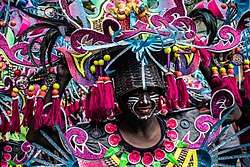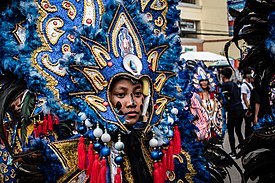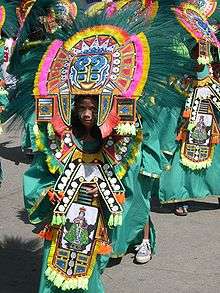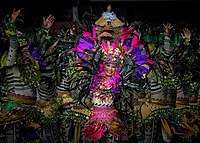Ati-Atihan festival
The Ati-Atihan Festival is a Philippine festival held annually in January in honor of the Santo Niño (Holy Child or Infant Jesus) in several towns of the province of Aklan, Panay Island. The biggest celebration is held during the third Sunday of January in the town of Kalibo, the province’s capital. The name Ati-Atihan means "to imitate Ati", the local name of the Aeta people, the first settlers of Panay Island and other parts of the archipelago. The festivity was originally a pagan celebration to commemorate the Barter of Panay, where the Aeta accepted gifts from Bornean chieftains called Datu, who fled with their families to escape a tyrannical ruler, in exchange for being allowed to dwell in the Aeta’s lands. They celebrated with dancing and music, with the Borneans having painted their bodies with soot to show their gratefulness and camaraderie with the Aeta who had dark skin. Later on, the festivity was given a different meaning by the church by celebrating the acceptance of Christianity, as symbolized by carrying an image of the Holy Child or Infant Jesus during the procession.
| Ati-Atihan | |
|---|---|
 An Ati-Atihan participant | |
| Observed by | Kalibo, Aklan, Philippines |
| Type | Religious / Cultural |
| Date | Third Sunday of January |

The festival consists of religious processions and street-parades, showcasing themed floats, dancing groups wearing colorful costumes, marching bands, and people sporting face and body paints. The street parade is known as "Sadsad", which is also what the locals call their way of dancing where the foot is momentarily dragged along the ground in tune to the beat played by the marching bands. Eventhough the festival was given a Christian meaning, the tradition of people painting their face and body, in honor of the Aeta, has continued. Christians and non-Christians join the celebration which attracts tourists from different parts of the country as well as foreigners. It has inspired other Philippine Festivals, including the Sinulog Festival of Cebu and Dinagyang of Iloilo City, and holds the title "The Mother of All Philippine Festivals".[1]
History
A 1200 A.D. event explains the origins of the festival. A group of 10 Malay chieftains called Datus, fleeing from the island of Borneo settled in the Philippines, and were granted settlement by the Ati people, the tribes of Panay Island. Datu Puti made a trade with the natives and bought the plains for a golden salakot, brass basins and bales of cloth. They gave a very long necklace to the wife of the Ati chieftain. Feasting and festivities followed soon after.

Some time later, the Ati people were struggling with famine as the result of a bad harvest. They were forced to descend from their mountain village into the settlement below, to seek the generosity of the people who now lived there. The Datus obliged and gave them food. In return, the Ati danced and sang for them, grateful for the gifts they had been given.
The festivity was originally a pagan festival from this tribe practicing Animism, and their worshiping their anito god. Spanish missionaries gradually added a Christian meaning. Today, the Ati-Atihan is celebrated as a religious festival.
In 2012, the National Commission for Culture and the Arts (NCCA) and the ICHCAP of UNESCO published Pinagmulan: Enumeration from the Philippine Inventory of Intangible Cultural Heritage. The first edition of the UNESCO-backed book included the Ati-atihan Festival, signifying its great importance to Philippine intangible cultural heritage. The local government of Aklan, in cooperation with the NCCA, is given the right to nominate the Ati-atihan Festival in the UNESCO Intangible Cultural Heritage Lists.[2]
Events

.
The formal opening mass during the first day of the celebration emphasizes the festival’s religious event. The mass is followed by a procession accompanied by rhythmic drumbeats and dance parades along the street. The second day begins at dawn with a rosary procession and ends with a community mass and another dance parade. The highlight of the festival occurs on the last day, the third Sunday of January, when groups representing different tribes compete for tourists' attention and prizes. The festival ends with a procession of thousands of people carrying different kinds of images of the Santo Niño. Throughout the dance parades, the phrase "Hala Bira!", which roughly translates as "pull through", is the ongoing chant of the revelers and devotees as they continue parading around town from morning until dawn of the next morning.
Others
Other towns in Aklan that celebrate the Ati-Atihan Festival are Ibajay, Malinao, Makato, Batan, Altavas, Malay (Boracay Island). Several nearby towns of Antique and Capiz also hold the Ati-Atihan Festival.
Other festivals held in the region with similar themes include:
References
- "The Ati-Atihan: Of devotion and free-flowing drinks in Kalibo". Retrieved 24 May 2020.
- "Pinagmulan: Enumeration from the Philippine Inventory of Intangible Cultural Heritage". www.ichcap.org. Retrieved 21 February 2018.
External links
| Wikimedia Commons has media related to Ati-Atihan Festival. |